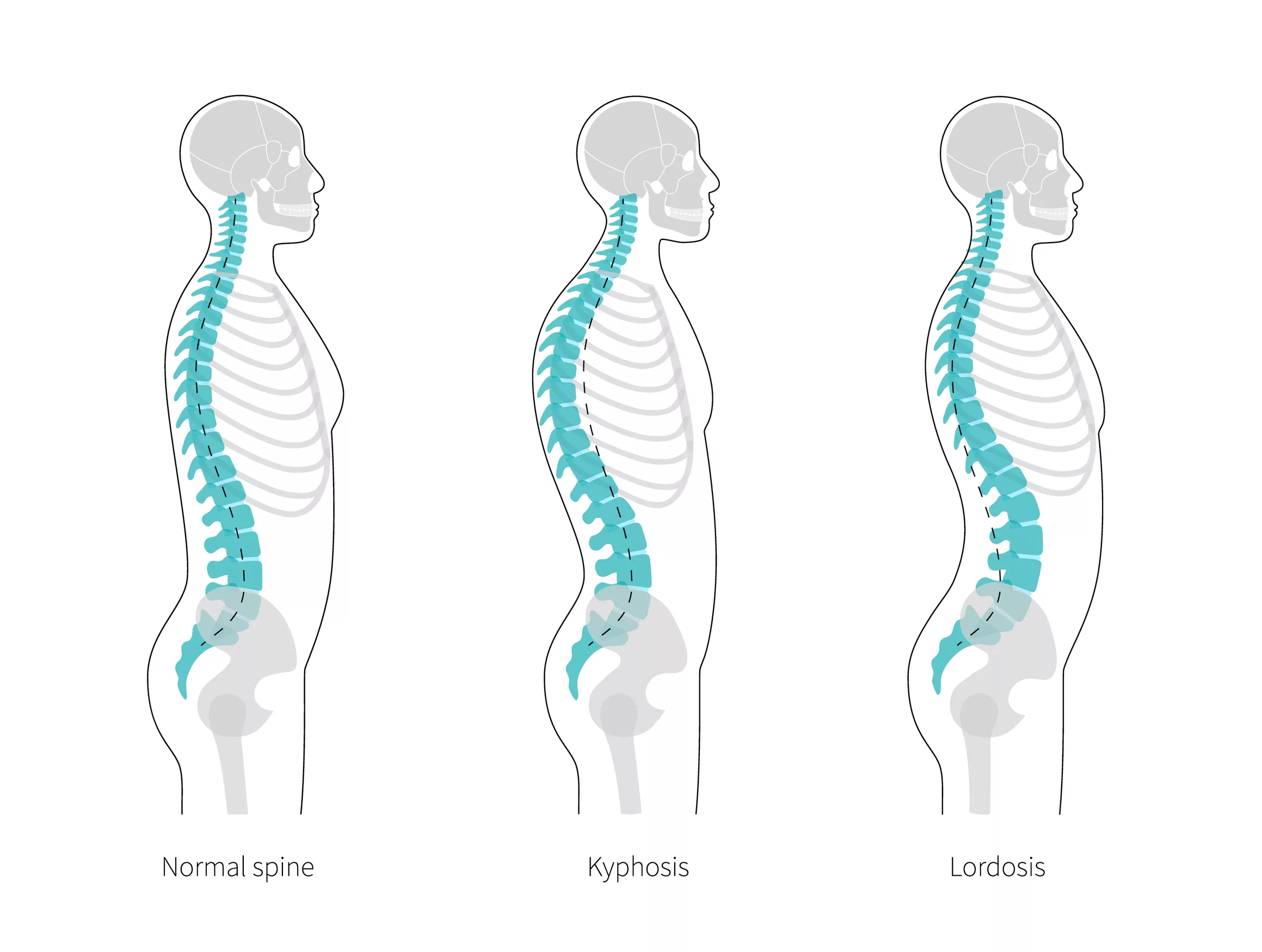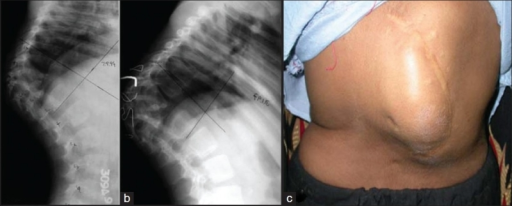What is Kyphosis?
Kyphosis, also known as a “Hunchback,” is when the upper spine curves more than usual, but sometimes, it might not cause noticeable signs or symptoms. It can, however, affect the appearance of your spine and, in some cases, may lead to pain and breathing issues.
“Hyperkyphosis” is when the angle of Kyphosis exceeds 40 degrees, and it can seriously impact your posture and movement.1 Lam JC, Mukhdomi T. Kyphosis. [Updated 2022 Dec 11]. In: StatPearls [Internet]. Treasure Island (FL): StatPearls Publishing; 2023 Jan-. Available from: https://www.ncbi.nlm.nih.gov/books/NBK558945/ Severe cases might even require surgical treatment.
Is Kyphosis the same as Lordosis?
Kyphosis refers to an increase in the forward curvature of the spine seen along the sagittal plane. Lordosis refers to the rise in the backward curvature of the spine in the same plane. Think of the sagittal plane as an imaginary glass wall that divides the human body into two halves. This division is in the longitudinal direction. Some degree of kyphosis is expected in the thoracic spine. Additionally, some lordosis is anticipated in the cervical and lumbar spine.

What are the types of Kyphosis?
There are three most common types of the condition.
- Postural Kyphosis
- Scheuermann’s kyphosis
- Congenital kyphosis
Postural Kyphosis
This is the most common type. The Postural variant usually presents during the teen years and is associated with carrying heavy loads or poor posture. It doesn’t cause any problems or pain and affects girls more than boys. These patients have normal vertebrae in their back. Poor posture stretches the ligaments and muscles connected to the vertebra. This can pull the vertebrae out of position, leading to a more rounded shape in the spine. Postural Kyphosis has a flexible curve. This means that changes in position lead to changes in spine curvature.
Scheuermann’s Kyphosis
Scheumermann’s Kyphosis affects those people who have “wedge-shaped” vertebrae.2Sardar ZM, Ames RJ, Lenke L. Scheuermann’s Kyphosis: Diagnosis, Management, and Selecting Fusion Levels. J Am Acad Orthop Surg. 2019 May 15;27(10):e462-e472. doi: 10.5435/JAAOS-D-17-00748. PMID: 30407981. Normally, vertebrae are shaped rectangularly. Wedge-shaped bones curve more forward, giving a rounded appearance to your back. This type also occurs more in teens and occurs before puberty. It is also known as juvenile kyphosis.
Unlike postural kyphosis, it affects boys more. Moreover, it is painful, especially during activity or prolonged inactivity(e.g., sitting for a long time). This type is more severe in underweight people and causes a rigid curve. This means that the curve will not change with a change in position.
Congenital Kyphosis
Congenital kyphosis is hyperkyphosis that has been present since birth. It is rarer than the other two types of kyphosis. This generally occurs with a baby whose spine did not develop properly before birth. This type needs surgery to prevent the curve from getting worse. It may occur with other birth defects and neurological complications. In this type, either one or more vertebral bodies fail to form, or two or more vertebral bodies fail to separate.
Are there any other causes of Kyphosis?
Aside from these three types, other causes include:
- Increased age
- Traumatic injuries (such as slipped discs)
- Infections in the spine(e.g., Pott’s disease due to advanced TB)
- Malignancies
Symptoms
The main symptom is having a “hunchback”. Additionally, Patients with Scheuermann disease commonly present with tight hamstrings. Other symptoms include:
- Pain and stiffness in the upper back and shoulders worsened with movement
- Mild to severe fatigue
- Shortness of breath (this is due to the spine pressing against airways)
- Balance issues
- Bowel/ Bladder incontinence
- There may be a difference in shoulder blade height or position.
Diagnosis
It usually becomes apparent to relatives such as parents or during a routine visit to your doctor. Your doctor will perform a physical exam to confirm his diagnosis. The “Adam’s forward bend test” is normally performed. This test requires the patient to bend forward, feet together, knees straight, and arms free. This allows the practitioner to see the curvature of your spine more clearly.3Medscape. (n.d.). Kyphosis Workup. Retrieved from https://emedicine.medscape.com/article/1264959-workup

X-ray is the gold standard for diagnosing abnormal spinal curvature(as shown above)4Jain AK, Dhammi IK, Jain S, Mishra P. Kyphosis in spinal tuberculosis – Prevention and correction. Indian J Orthop. 2010 Apr;44(2):127-36. doi: 10.4103/0019-5413.61893. PMID: 20418999; PMCID: PMC2856387. X-rays use invisible electromagnetic radiation to produce images of internal body structures. This is typically a standing lateral spine X-ray. Elderly patients can opt for a supine X-ray. (This provides more comfort). The physician can then calculate Cobb’s angle—one of the most commonly used metrics for spinal deformities. The average kyphosis angle ranges from 35 to 42 degrees. Angles greater than 40 indicate hyperkyphosis.
Treatments
The treatment depends on age, medical history, and type of disease. Nonsurgical treatment is most often prescribed for Postural Kyphosis and some forms of Schheuermann’s kyphosis. Kyphosis causes severe pain or significant difficulties in daily life, so surgery to reduce curvature can help relieve symptoms. Congenital Kyphosis and severe Scheuermann Kyphosis with a curve greater than 75 degrees are also treated via surgical means.
Non-surgical treatments:
These are combined with regular monitoring of symptoms and regular X-rays to monitor the condition’s progression. Nonsurgical treatments include:
- Physical therapy: This can strengthen the abdominal and back muscles to improve posture and pain.
- Pain killers: These medications are there to decrease pain and inflammation.
- Supportive brace: A back brace may be provided in some cases. This is generally provided to support the back. A brace is more commonly prescribed for actively growing children, especially those with Scheumermann’s Kyphosis.5Weiss HR, Turnbull D, Bohr S. Brace treatment for patients with Scheuermann’s disease – a review of the literature and first experiences with a new brace design. Scoliosis. 2009 Sep 29;4:22. Doi: 10.1186/1748-7161-4-22. PMID: 19788753; PMCID: PMC2761858.
Scheuermann’s Kyphosis may also be treated with non-surgical options for curves lesser than 75 degrees.
Surgical treatments:
The most popular treatment is “Posterior Spinal Fusion with Instrumentation.”6Huq S, Ehresman J, Cottrill E, Ahmed AK, Pennington Z, Westbroek EM, Sciubba DM. Treatment approaches for Scheuermann kyphosis: a systematic review of historic and current management. J Neurosurg Spine. 2019 Nov 1;32(2):235-247. Doi: 10.3171/2019.8.SPINE19500. PMID: 31675699.
During this procedure, surgeons make an incision in your back to access the spine. They prepare the bones and secure them with small titanium screws, which are placed on both sides of the vertebrae using a strong bone structure called the pedicle. The pedicle is a sturdy part of each vertebra that helps support the screws. The center of the vertebral column is hollow and holds the spinal cord and cerebrospinal fluid. To protect the spinal cord, surgeons use real-time X-rays and attach electrodes to monitor its activity from head to toe. A specialist interprets the signals and tells the surgeon if there are any changes.
Once the screws are in place, they carefully adjust the spine’s arch during the surgery. They use cobalt chrome rods to hold everything in position. Interestingly, they even use a piece of your rib as a bone graft. They cut the rib into small pieces and place them along your spine to help it fuse. However, it is to be noted that Kyphosis can reoccur after treatment.7Hopkins Medicine. (n.d.). Kyphosis. Retrieved from https://www.hopkinsmedicine.org/health/conditions-and-diseases/kyphosis
Prevention
Postural kyphosis can be prevented. Prevention can be accomplished by:
- Maintaining healthy weight and posture.
- Strengthening the abdominal and back muscles through exercise.
- Avoid using heavy school bags, etc.
Is there any difference between Kyphosis and Scoliosis?
Kyphosis involves excessive forward curvature of the upper spine, leading to a rounded back appearance. At the same time, scoliosis is characterized by an abnormal sideways curvature of the spine, creating an “S” or “C” shape. Both conditions can vary in severity and may or may not cause symptoms.8Janicki, J. A., & Alman, B. (2007). Scoliosis: Review of diagnosis and treatment. Paediatrics & child health, 12(9), 771–776. https://doi.org/10.1093/pch/12.9.771
Scoliosis can develop during adolescence (adolescent idiopathic scoliosis), be present from birth (congenital scoliosis), or be caused by other underlying conditions. Severe scoliosis can cause cosmetic issues, such as uneven shoulders, hips, or ribcage, and in some cases, it may lead to breathing difficulties.
Conclusion
Kyphosis, also known as “Hunchback,” is a condition where the upper spine curves more than usual, sometimes leading to pain and breathing issues. Generally, there are three different types of kyphosis. Congenital forms potentially have the most severe symptoms, while others may be asymptomatic. X-ray is the most accurate diagnostic method and is crucial for early detection and treatment. While nonsurgical options are often recommended, severe cases may require surgery, like “Posterior Spinal Fusion with Instrumentation.” Taking preventive measures, such as maintaining a healthy weight and posture, can play a significant role in safeguarding your spinal health.
Refrences
- 1Lam JC, Mukhdomi T. Kyphosis. [Updated 2022 Dec 11]. In: StatPearls [Internet]. Treasure Island (FL): StatPearls Publishing; 2023 Jan-. Available from: https://www.ncbi.nlm.nih.gov/books/NBK558945/
- 2Sardar ZM, Ames RJ, Lenke L. Scheuermann’s Kyphosis: Diagnosis, Management, and Selecting Fusion Levels. J Am Acad Orthop Surg. 2019 May 15;27(10):e462-e472. doi: 10.5435/JAAOS-D-17-00748. PMID: 30407981.
- 3Medscape. (n.d.). Kyphosis Workup. Retrieved from https://emedicine.medscape.com/article/1264959-workup
- 4Jain AK, Dhammi IK, Jain S, Mishra P. Kyphosis in spinal tuberculosis – Prevention and correction. Indian J Orthop. 2010 Apr;44(2):127-36. doi: 10.4103/0019-5413.61893. PMID: 20418999; PMCID: PMC2856387.
- 5Weiss HR, Turnbull D, Bohr S. Brace treatment for patients with Scheuermann’s disease – a review of the literature and first experiences with a new brace design. Scoliosis. 2009 Sep 29;4:22. Doi: 10.1186/1748-7161-4-22. PMID: 19788753; PMCID: PMC2761858.
- 6Huq S, Ehresman J, Cottrill E, Ahmed AK, Pennington Z, Westbroek EM, Sciubba DM. Treatment approaches for Scheuermann kyphosis: a systematic review of historic and current management. J Neurosurg Spine. 2019 Nov 1;32(2):235-247. Doi: 10.3171/2019.8.SPINE19500. PMID: 31675699.
- 7Hopkins Medicine. (n.d.). Kyphosis. Retrieved from https://www.hopkinsmedicine.org/health/conditions-and-diseases/kyphosis
- 8Janicki, J. A., & Alman, B. (2007). Scoliosis: Review of diagnosis and treatment. Paediatrics & child health, 12(9), 771–776. https://doi.org/10.1093/pch/12.9.771

